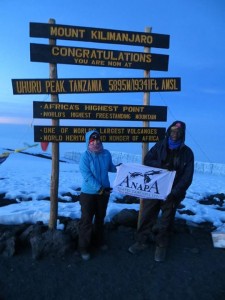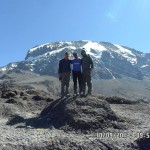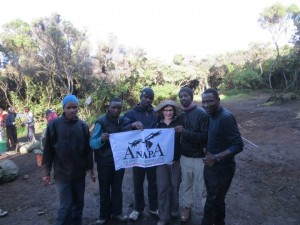 Mount Kilimanjaro is the highest Mountain in Africa whereby it is 200 miles south of the equator and is an extinct volcanic Mountain measuring up to 19,341 feet in height /5,895 meters above the sea level. Kilimanjaro is Africa’s highest peak and the world’s highest free-standing mountain which is walk able summit. Mount Kilimanjaro is located in northern Tanzania and is the crown of Tanzania. Rising abruptly from the open plains, capped by snow and frequently fringed by clouds, it is one of Africa’s classic images.
Mount Kilimanjaro is the highest Mountain in Africa whereby it is 200 miles south of the equator and is an extinct volcanic Mountain measuring up to 19,341 feet in height /5,895 meters above the sea level. Kilimanjaro is Africa’s highest peak and the world’s highest free-standing mountain which is walk able summit. Mount Kilimanjaro is located in northern Tanzania and is the crown of Tanzania. Rising abruptly from the open plains, capped by snow and frequently fringed by clouds, it is one of Africa’s classic images.

Kilimanjaro is a dormant, but not extinct volcano. Worrying thunder can sometimes be heard and gases emerge from the fumaroles in the crater. The diameter of its base is an incredible Forty (40) kilometers. Mount Kilimanjaro can only be safely attempted while you are in Tanzania and any assistance due to health problem can be easily overtaken by experienced guides in Tanzania.
Kilimanjaro today’s Weather
 Weather Conditions near the base of the mountain tend to be tropical to semi-temperate and are relatively stable all year round. The lower plains are hot and dry with average temperatures of around 90 degrees Fahrenheit. As one heads away from the Lower Plains towards the Rain Forest, conditions become increasingly warm and humid.
Weather Conditions near the base of the mountain tend to be tropical to semi-temperate and are relatively stable all year round. The lower plains are hot and dry with average temperatures of around 90 degrees Fahrenheit. As one heads away from the Lower Plains towards the Rain Forest, conditions become increasingly warm and humid.
Mount Kilimanjaro is divided into five distinct zones: Cultivated farmlands on the lowest levels, next is therainforest zone, followed by heath and moorland with alpine vegetation, and just before the barren, snowy summit is lunar-like desert.
We recommend to our clients who wants to climb Kilimanjaro that the long rains typically occur from *End of February to end April*, and basically it is at this time when visibility is bad and the mountain becomes slippery and treacherous. The shorter rains occur during November and December, June through October it is a summer time and conducive for climbing the Mountain.
Kilimanjaro routes
 The Mount Kilimanjaro is attempted using its six popular routes, of which one is commonly used for descending only the Mweka route. Another routes include the Marangu , which is both used for climbing and descending after climbing using other routes such as Machame, Rongai, Lemosho, Umbwe, Shira and itself.
The Mount Kilimanjaro is attempted using its six popular routes, of which one is commonly used for descending only the Mweka route. Another routes include the Marangu , which is both used for climbing and descending after climbing using other routes such as Machame, Rongai, Lemosho, Umbwe, Shira and itself.
Marangu is the only route with huts as accommodations leaving others to accommodate hikers using the mobile tents. Each route in Kilimanjaro has its different challenge and view and landscape but the bottom line is to reach to the Roof to of Africa which is Uhuru Peak.
Climbers during their time on the mountain, pass from a tropical to arctic environment in just a few days. The various trails first pass through lush rainforests before reaching heather and open moorland where giant lobelia and huge, cactus-like groundsel grow. Above this moorland is the almost lunar landscape of an alpine desert which stretches between the two peaks of Kibo, the flat-topped dome at the centre, and Mawenzi, a group of jagged points and pinnacles on the eastern side.
Your Kilimanjaro Safety& Successfully climb.
Your safety on Kilimanjaro is our number one priority. Before you even arrive on the mountain this begins with planning routes that ensure good acclimatization. We recruit and train the very best guides and we use world class equipment.
Once you are on the mountain we do everything possible to ensure you remain healthy. We monitor your health closely to spot the early warning signs of problems. As a company we run a full Safety Management System. This begins with establishing clear safety objectives then looks at detailed risk assessments. We then design our procedures to minimize those risks. We then listen to feedback to ensure that our safety protocols are continually improving.
We have a Public Liability Insurance and, in order to obtain this, our safety protocols and risk assessments are reviewed annually.
Key features of our safety protocols
Certified Wilderness First Responder trained guides
 All of our guides are certified as Wilderness First Responders. This means they have the skills necessary to handle medical emergencies on the mountain in a way that reduces the risk of serious outcomes.
All of our guides are certified as Wilderness First Responders. This means they have the skills necessary to handle medical emergencies on the mountain in a way that reduces the risk of serious outcomes.
Twice daily health checks
At the start and end of each day our guide will check your health and carefully record important information so that we can see if anything is starting to go wrong.
Twice daily oxygen saturation tests
Pulse oximeter our guides will use a pulse oximeter to measure the oxygen level in your blood and your pulse rate in the morning and evening. The oximeter is placed on a climber’s fingertip. The oximeter uses two beams of light that shine into small blood vessels and capillaries in your finger. The sensor reflects the amount of oxygen in the blood.
 Oxygen saturation is a measurement of how much oxygen your blood is carrying as a percentage of the maximum it could carry. Normal blood oxygen levels at sea level are 95-100%.
Oxygen saturation is a measurement of how much oxygen your blood is carrying as a percentage of the maximum it could carry. Normal blood oxygen levels at sea level are 95-100%.
As altitude increases, oxygen saturations decrease. Proper acclimatization generally brings oxygen saturations higher, which is why these figures typically rise when oxygen saturations are tested after resting overnight. On Kilimanjaro, oxygen saturations percentages are regularly in the 80’s. However, if oxygen saturation is ever less than 80%, we monitor that climber very closely.
Emergency oxygen Tank
We carry bottled oxygen on all of our climbs as a precaution and additional safety measure. The oxygen canister is for use only in emergency situations. It is NOT used to assist clients who have not adequately acclimatized on their own to climb higher. The most immediate treatment for moderate and serious altitude sickness is descent. With Kilimanjaro routes, it is always possible to descend, and descend quickly. Therefore, oxygen is used strictly to treat a stricken climber, when necessary, in conjunction with descent, to treat those with moderate and severe altitude sickness.
 We are aware that some operators market the use of supplementary personal oxygen systems as a means to eliminate the symptoms of AMS. To administer oxygen in this manner and for this purpose is dangerous because it is a temporary treatment of altitude sickness. Upon the cessation of the use of oxygen, the client will be at an even higher altitude without proper acclimatization.
We are aware that some operators market the use of supplementary personal oxygen systems as a means to eliminate the symptoms of AMS. To administer oxygen in this manner and for this purpose is dangerous because it is a temporary treatment of altitude sickness. Upon the cessation of the use of oxygen, the client will be at an even higher altitude without proper acclimatization.
99% of the Companies on Kilimanjaro do NOT offer supplementary oxygen – because it is potentially dangerous, wholly unnecessary and against the spirit of climbing Kilimanjaro. The challenge of the mountain lies within the fact that the summit is at a high elevation, where climbers must adapt to lower oxygen levels at altitude. Using supplementary oxygen is akin to putting the mountain at sea level, where nearly everyone can summit. Supplementary Oxygen contribute a lot in ensuring your health safety on Kilimanjaro.
 Helicopter Evacuations
Helicopter Evacuations
We are using specialized Airbus AS 350 B3 helicopters partner with Kilimanjaro Sar, positioned at Moshi Airport in Tanzania. It’s the ideal location for high altitude Kilimanjaro search and rescue operations for Our team is highly experienced and we have a perfect safety record.
Portable Stretcher
 Large, one-wheeled rescue stretchers are found on Mount Kilimanjaro but they are only available within a small area of the park. That means that if a climber is unable to walk due to severe altitude sickness or a leg injury that compromises mobility, getting that climber down the mountain could pose difficult challenges for Kilimanjaro operators. Usually it means assisting the injured climber by carrying him or her on one’s back.
Large, one-wheeled rescue stretchers are found on Mount Kilimanjaro but they are only available within a small area of the park. That means that if a climber is unable to walk due to severe altitude sickness or a leg injury that compromises mobility, getting that climber down the mountain could pose difficult challenges for Kilimanjaro operators. Usually it means assisting the injured climber by carrying him or her on one’s back.
At ANAPA Travel, we carry a portable stretcher at all times in case of emergencies when a climber is unable to walk on their own and the trekking party is some distance away from the park’s stretchers. Our portable stretchers are compact, strong and lightweight. The device can be used to evacuate an injured climber quickly off the mountain. To use, the subject is secured to the stretcher using straps. Then porters hold on to the hand grips to usher the climber to safety.
Climb Kilimanjaro Safely and Successfully with ANAPA Travel Africa Tours. Safety on Kilimanjaro Climb, is our number one priority
Kilimanjaro map
Click link to See Kilimanjaro climbing Routes packages
Also got some Climbing Questions? To clear your doubts, We’re Online Click WHATSAPP chat with us!


